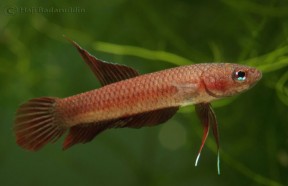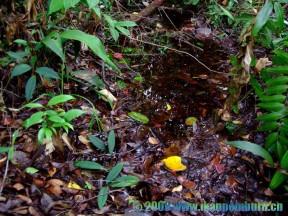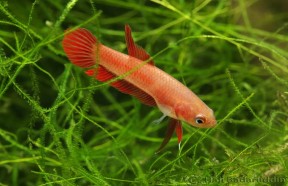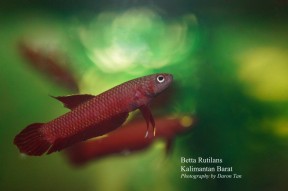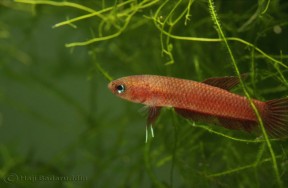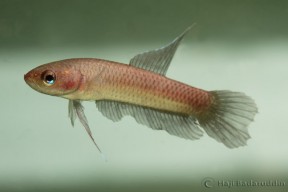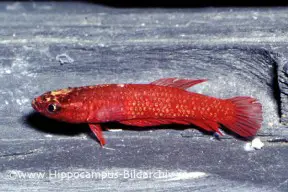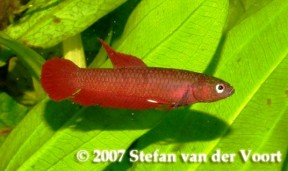Betta rutilans
Etymology
rutilans: from the Latin participle rutilans, meaning ‘being red’.
Classification
Osphronemidae
Distribution
The species has been collected from localities connected with the rivers Mempawah and Kepayang close to the town of Anjungan in Kalimantan Barat (West Kalimantan) province, Borneo, Indonesia.
Type locality is ‘Sungei Kepayang, 7 kilometers southeast of Anjungan on road to Pontianak, 0°20’N, 109°08’E, Kalimantan Barat, Borneo’.
Habitat
A stenotypic inhabitant of peat swamp forests and associated black water streams.
The dense canopy of branches above means very little light penetrates the surface of such environments, and riparian vegetation also tends to grow thickly.
The water is typically stained darkly with humic acids and other chemicals released by decaying organic material.
The dissolved mineral content is generally negligible and pH can be as low as 3.0 or 4.0.
The substrate is usually covered by fallen leaves, branches and submerged tree roots and at certain times of year the fish may be forced to survive within the moist leaf litter for several weeks as permanent water is not always available.
Maximum Standard Length
30 – 35 mm.
Aquarium SizeTop ↑
An aquarium with base measurements of 45 ∗ 30 cm should be the minimum considered.
Maintenance
Can be maintained in a fully-decorated aquarium although many breeders prefer not to use a substrate for ease of maintenance.
Driftwood roots and branches can be used and placed such a way that a few shady spots are formed while clay plant pots or lengths of piping can also be included to provide further shelter.
The addition of dried leaf litter further emphasises the natural feel and as well as offering additional cover for the fish brings with it the growth of microbe colonies as decomposition occurs.
These can provide a valuable secondary food source for fry and the tannins and other chemicals released by the decaying leaves are also considered beneficial for fishes from blackwater environments.
There is no need to use natural peat, however, the collection of which is both unsustainable and environmentally-destructive.
Like others in the genus this species seems to do best under fairly dim lighting.
You could add aquatic plant species that can survive under such conditions such as Microsorum, Taxiphyllum or Cryptocoryne spp., and a few patches of floating vegetation would be useful as well.
This species requires acidic conditions with negligible carbonate hardness and very low general hardness so a reverse osmosis unit or other method of obtaining soft water may need to be employed, and this can be further acidified using phosphoric acid or similar if necessary.
As it naturally inhabits sluggish waters filtration should not be too strong, with an air-powered sponge filter set to turn over gently adequate.
Keep the tank well-covered and do not fill it to the top as like all Betta spp. it requires occasional access to the layer of humid air that will form above the water surface, and is an excellent jumper.
Water Conditions
Temperature: 22 – 27 °C
pH: 3.0 – 6.0
Hardness: 18 – 90 ppm
Diet
Likely to prey on insects and other small invertebrates in nature.
Captive fish will normally accept dried products once they’re recognised as edible, but should be offered plenty of small live or frozen foods such as Daphnia, Artemia or bloodworm regularly to ensure development of optimum colour and condition.
Take care not to overfeed as Betta spp. seem particularly prone to obesity.
Behaviour and CompatibilityTop ↑
Not recommended for the standard community set-up for reasons already touched upon.
It’s care requirements and disposition mean it is best kept alone or with very peaceful species since much bigger or more vigorous fishes are likely to intimidate and outcompete it.
Some small cyprinids and loaches that inhabit similar environments in nature are suitable, but proper research prior to purchase is essential.
Mixed reports exist as to whether it can be maintained in multiple pairs or harem-type groups comprising a single male alongside several females.
Some observe that although some chasing and squabbling over territory occurs actual physical damage is rare, while others recommend keeping it in single pairs having observed sustained aggression towards conspecifics from the dominant individuals in a group.
Sexual Dimorphism
Mature females tend to be slightly rounder in the belly than males and exhibit slightly duller colouration.
Adult males also develop marginally more extended ventral, anal and dorsal fins.
Reproduction
Bubble-nester. It’s particularly important to provide plenty of cover for the female, and empty camera film canisters or lengths of plastic tubing are often used to offer potential nesting sites.
Floating plants may be incorporated into the nest if present.
The tank should have the tightest-fitting cover you can find (some breeders use clingfilm instead, to ensure no gaps) because the fry need access to a layer of warm, humid air without which development of the labyrinth organ can be impaired.
The pair need not be separated prior to spawning.
The male may construct the nest in a tube or canister, under a broad plant leaf or among fine-leaved surface vegetation, and will not usually tolerate the female in the vicinity until it’s complete.
Just prior to spawning the body colour of the female pales and dark bars appear on the flanks, with the act itself normally occurring below the nest in an ‘embrace’ typical of osphronemids, with the male wrapping himself around the female.
At the point of climax milt and a few eggs are released which the female proceeds to catch between pelvic fins and body.
The male then transfers them to his nest while the female recovers any that fell.
This cycle is then repeated until the female is spent of eggs, a process that can take some time.
This is not a particularly prolific species with less than 20 eggs being typical although bigger broods of up to 50 are not uncommon.
Post-spawning the adults can normally be left in situ although the female is no longer actively involved with the male assuming sole responsibility for guarding and tending the nest.
The eggs hatch in 24-48 hours, remaining in the nest for a further 3-4 days until the yolk sac is fully-absorbed, while the male continues to collecting and return any that fall.
Once the fry begin to swim freely the male will lose interest, but the adults do not usually eat their offspring.
The fry are large enough to accept motile foods such as microworm and Artemia nauplii immediately, though it should be noted that there exist reports of young Betta developing health issues if fed excessive amounts of the latter.
Offer small amounts of different foods 2 -3 times per day for optimal growth rate, and don’t change too much water at once, with regular, small changes preferable to intermittent larger ones.
NotesTop ↑
This species is included in the B. coccina group of closely-related species within the genus, and prior to description was known as B. sp. ‘Anjungan’ in the aquarium hobby.
This assemblage mostly comprises small, red-coloured fishes with the exceptions of B. hendra, B. persephone and B. miniopinna which are greenish or darkish, and identifying some of them can be problematic as external patterning can be both similar and confusingly variable.
Members of the B. coccina group possess the following shared characters: small adult size (up to 40 mm SL); either red or black body colouration; presence of midlateral blotch in some species; 9 abdominal vertebrae (vs. 10-12 in all other Betta species); stenotypic inhabitants of forest peat swamps.
B. rutilans can be told apart from other members of the group by the following combination of characters: body uniformly deep red in colour; no midlateral blotch on body; no parallel, vertical gold bars on opercle; pelvic fin red with white filamentous tip; dorsal-fin rays 11-12; anal-fin rays 27-28; subdorsal scales 8-10 (mode 9); lateral scales 30-31; predorsal scales 25-27.
The genus Betta is the most speciose within the family Osphronemidae with almost 70 recognised members and looks set to grow further with new ones continuing to be described on a regular basis since the turn of the century.
Member species have successfully adapted to inhabit a variety of ecological niches from stagnant ditches to flowing hill streams including some extreme environments such as highly acidic peat swamp forests.
The referral of members to a number of groups containing closely-related species is now generally accepted but largely based on morphological and behavioural characters.
Molecular phylogenetic work may therefore prove useful in more precisely determining relationships between these fishes.
A full list of the species groups as currently recognised can be found here.
Like others in the suborder Anabantoidei this species possesses an accessory breathing organ known as the labyrinth.
So-called due to its maze-like structure this organ allows the fish to breathe atmospheric air to a certain extent.
Comprising paired suprabranchial organs formed via expansion of the epibranchial (upper) section of the first gill arch and housed in a chamber above the gills, it contains many highly-vascularised, folded flaps of skin which function as a large respiratory surface.
Its structure varies in complexity between species, tending to be better-developed in those inhabiting harsher environments.
References
- Kottelat, M., 1991 - Ichthyological Exploration of Freshwaters 2(3): 273-287
Notes on the taxonomy and distribution of some western Indonesian freshwater fishes, with diagnoses of a new genus and six new species (Pisces: Cyprinidae, Belontiidae, and Chaudhuriidae). - Schindler, I. and J. Schmidt, 2006 - Zeitschrift für Fischkunde 8(1/2): 47-69
Review of the mouthbrooding Betta (Teleostei, Osphronemidae) from Thailand, with descriptions of two new species. - Tan, H. H. and P. K. L. Ng, 2005 - Raffles Bulletin of Zoology Supplement (13): 43-99
The fighting fishes (Teleostei: Osphronemidae: Genus Betta) of Singapore, Malaysia and Brunei. - Witte, K.-E. and J. Schmidt, 1992 - Ichthyological Exploration of Freshwaters 2(4): 305-330
Betta brownorum, a new species of anabantoids (Teleostei: Belontiidae) from northwestern Borneo, with a key to the genus.

